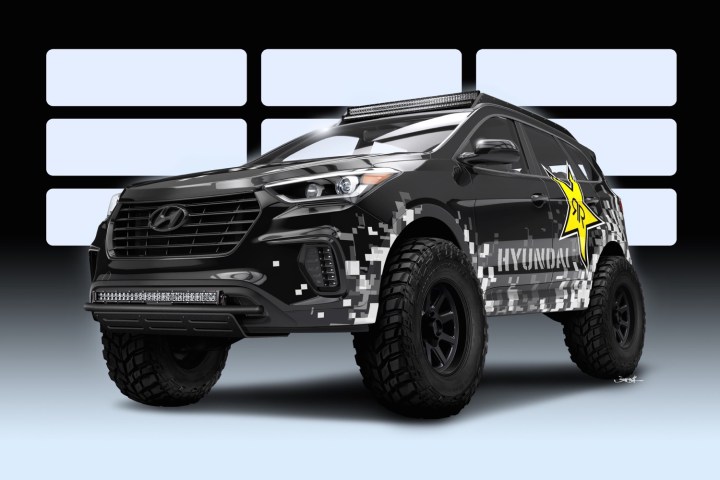
That’s what Hyundai and the Rockstar energy drink company had in mind when they concocted the Rockstar Santa Fe concept. Set to debut at the annual SEMA aftermarket trade show in Las Vegas next month, it’s the kind of modified creation you’d expect a group of people to come up with after a night of pounding the energy drinks it’s sponsored by.
Hyundai turned the Santa Fe from a soccer-mom shuttle into a monster truck, installing a completely new suspension system that jacks up the ride height for extra ground clearance, and features aftermarket King shocks to soak up bumps. The Rockstar Santa Fe concept rides on massive 35-inch Mickey Thompson Baja Claw tires, fitted to 17-inch bead-lock wheels. Designed for off-road and military vehicles, bead-lock wheels allow the tire to be bolted to the rim, so it doesn’t come off if when deflated.
As if the wheel-and-tire package didn’t give the Rockstar Santa Fe enough attitude, Hyundai added LED light bars, rock sliders and bumpers, and a custom roof rack. A winch is also onboard in case the Santa Fe gets stuck somewhere out in the wilderness, although this rig will probably spend most of its time on display at auto shows. The interior is fully customized, with leather upholstery.
The 3.3-liter V6 shared with stock Santa Fes was treated to a custom exhaust system and nitrous oxide. That means it should make more than the stock version’s 290 horsepower and 252 pound-feet of torque, but Hyundai wouldn’t quote a specific power output. The Korean carmaker will also bring a 1,000-hp Santa Fe built by tuner Bisimoto to SEMA, so clearly there’s some potential in that engine.
The Santa Fe may be a competent family crossover, but it’s an unlikely choice for off roading, or modification in general. That just goes to show how crazy SEMA concept cars can get, and there are more on the way. Be sure to check back for the latest updates as SEMA draws closer.
Editors' Recommendations
- 2022 Hyundai Santa Cruz first drive: Finally, something new
- New Hyundai Ioniq electric vehicle gets big boosts in range and horsepower
- Hyundai upgrades its Veloster N with the best the aftermarket has to offer
- Hyundai turns the Veloster into an off-roader for America’s biggest tuning show
- Forget sedans and SUVs, Hyundai wants to develop its own flying taxis


